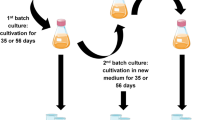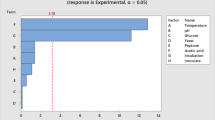Abstract
Bacterial cellulose (BC), pure cellulose, has become a new material for cellulose-based products due to its unique properties such as high crystallinity, precise nanostructure, high biocompatibility, high mechanical strength, biodegradability, non-toxicity, 3-dimensional molding capacity, etc. In this study, the availability of Alcohol Lees, by-product of alcohol production as a cheap carbon and nitrogen source, was evaluated for bacterial cellulose production and then the BC was produced in layer-by-layer form with high productivity without any additives using an Intermittent Feeding Strategy. The synergic effects between Alcohol Lees dilution (60–100%), pH (3.5–7.5), Intermittent Feeding Height (0.5–2.5 mm), and Intermittent Feeding Interval (0–48 h) were analyzed for maximum BC production by respond surface methodology. The optimal condition for maximum BC production in the Intermittent Feeding Strategy were Alcohol Lee dilution (86.2%), pH (5.6), Intermittent Feeding Height (1.4 mm), Intermittent Feeding Interval (22.2 h) and its maximum BC yield was 4.41 ± 0.06 g L−1 compared to the conventional static culture of BC with 2.03 ± 0.05 g L−1 yield in 1-week-culture. BC produced either with HS medium or AL medium indicate similar characteristic figure in Fourier transform infrared spectra and scanning electron microscope and show similar crystalline structure but lower cellulose crystallinity in the AL sample (58.9%) compared to HS sample (63.9%) in X-ray diffraction. This work provides a potential opportunity to propose alternative medium and to highlight the availability of Alcohol Lee, food waste for BC production.





Similar content being viewed by others
Abbreviations
- ALs:
-
Alcohol lees, crude liquor
- ANOVA:
-
Analysis of variance
- BC:
-
Bacterial cellulose
- CCRD:
-
Central composite rotational design
- HS:
-
Hestrin and Scharman medium
- IFH:
-
Intermittent feeding height
- IFI:
-
Intermittent feeding interval
- IFS:
-
Intermittent feeding strategy
- OPAT:
-
One parameter at a time
- RSM:
-
Response surface methodology
- XRD:
-
X-ray diffraction
- FT-IR:
-
Fourier Transform Infrared Spectroscopy
- SEM:
-
Scanning electron microscopy
- 3-D:
-
Three dimensional
- R2 :
-
Coefficient of determination
- β0 :
-
Value of the fitted response at the center point of the design
- βi :
-
Linear term
- βii :
-
Quadratic term
- βij :
-
Cross point term
- ε:
-
Random error
References
Aswini K, Gopal NO, Uthandi S (2020) Optimized culture conditions for bacterial cellulose production by Acetobacter senegalensis MA1. BMC Biotechnol 20:46. https://doi.org/10.1186/s12896-020-00639-6
Carreira P, Mendes JAS, Trovatti E et al (2011) Utilization of residues from agroforest industries in the production of high value bacterial cellulose. Bioresour Technol 102:7354–7360
Castro C, Zuluaga R, Putaux J-L, Caro G, Mondragon I, Gañán P (2011) Structural characterization of bacterial cellulose produced by Gluconacetobacter swingsii sp. from Colombian agroindustrial wastes. Carbohyd Polym 84:96–102
Castro C, Zuluaga R, Álvarez C, Putaux J-L, Caro G, Rojas OJ, Mondragon I, Gañán P (2012) Bacterial cellulose produced by a new acid-resistant strain of Gluconacetobacter genus. Carbohyd Polym 89:1033–1037
Charreau H, Foresti ML, Vazquez A (2013) Nanocellulose patents trends: a comprehensive review on patents on cellulose nanocrystals, microfibrillated and bacterial cellulose. Recent Pat Nanotechnol 7(1):56
Chawla PR, Bajaj IB, Survase SA, Singhal RS (2009) Microbial cellulose: fermentative production and applications. Food Technol Biotechnol 47(2):107–109
Costa AFS, Almeida FCG, Vinhas GM, Sarubbo LA (2017) Production of bacterial cellulose by gluconacetobacter hanseniiusing corn steep liquor as nutrient sources. Front Microbiol 8:2027
Dai R., (2012) Study on mechanism of enhancing bacterial cellulose production with ethanol and acetic acid as synergistic agent. Master's Thesis, Guizhou University, Guiyang, China, pp 32–45
Dirisu CG, Braide W (2018) Bacterial cellulose production from mature black spear grass hydrolysate by Gluconacetobacter xylinus: effect of pH, fermentation time and nitrogen supplementation. Int J Curr Microbiol Appl Sci 7(8):1616–1627
Dorame-Miranda RF, Gamez-Meza N, Medina-Juarez LA, Ezquerra-Brauer JM, Ovando-Martinez M, Lizardi-Mendoza J (2018) Bacterial cellulose production by Gluconacetobacter entanii using pecan nutshell as carbon source and its chemical functionalization. Carbohyd Polym 207:91–99
El-Saied H, Basta AH, Gobran RH (2004) Research progress in friendly environmental technology for the production of cellulose products (Bacterial Cellulose and Its Application). Polym-Plast Technol Eng 43(3):797–820
Esam J, AL-Kalifawi EJ (2014) Factors influence on the yield of bacterial cellulose of Kombucha, Baghdad. Sci J 11:3
Gilndilz G, Asik N (2018) Production and characterization of bacterial cellulose with different nutrient source and surface-volume ratios. DRVNA INDUSTRIJA 69(1):141–148
Gomes FP, Silva NH, Trovatti E, Serafim LS, Duarte MF, Silvestre AJ, Neto CP, Freire CS (2013) Production of bacterial cellulose by Gluconacetobacter sacchari using dry olive mill residue. Biomass Bioenergy 355:205–211
Halib N, Amin MCIM, Ahmad I (2012) Physicochemical properties and characterization of nata de coco from local food industries as a source of cellulose. Sains Malays 41:205–211
Hestrin S, Schramm M (1954) J Biochem 58:345–352
Hong F, Qiu K (2008) An alternative carbon source from konjac powder for enhancing production of bacterial cellulose in static cultures by a model strain Acetobacter aceti subsp. xylinus ATCC 23770. Carbohydr Polym 72(3):545–549
Hsieh J-T, Wang M-J, Lai J-T, Liu H-S (2016) A novel static cultivation of bacterial cellulose production by intermittent feeding strategy. J Taiwan Inst Chem Eng 000:1–6
Huang C, Guo H-J, **ong L, Wang Bo, Shi S-L, Chen X-F, Lin X-Q, Wang C, Luo J, Chen X-D (2016) Using wastewater after lipid fermentation as medium for bacterial cellulose production by Gluconacetobacter xylinus. Carbohyd Polym 136:198–202
Jaleha BS (2012) Optimization of Bacterial cellulose production from Acetobacter xylinum by using response surface methodology (RSM). B.S. Dissertation. Faculty of Chemical Engineering and Natural Resources University. Malaysia PaHang 39–79.
Joye IJ, McClements DJ (2016) Biopolymer-based delivery systems: challenges and opportunities? Curr Top Med Chem 16(9):1026–1039
Keshk SMAS, Razek TMA, Sameshima K (2006) Bacterial cellulose production from beet molasses. Afr J Biotechnol 5(17):1519–1523
Kjeldahl J (1883) Neue methode zur bestimmung des stickstoffs inorganischen körpern. Z Anal Chem 22:366–382
Kongruang S (2008) Bacterial cellulose production by Acetobacter xylinum strains from agricultural waste products. Appl Biochem Biotechnol 148:245–256
Kumar D, Hager A-S, Sun A, Debyser W, Guagliano BJ, Singh V (2019) Improving fermentation rate during use of corn grits in beverage alcohol production. Beverages 5:5. https://doi.org/10.3390/beverages501000
Kurosumi A, Sasaki C, Yamashita Y, Nakamura Y (2009) Utilization of various fruit juices as carbon sources for production of bacterial cellulose by Acetobacter xylinum NBRC 13693. Carbohyd Polym 76(2):333–335
Lima HLS, Nascimento ES, Andrade FK, Brigida AIS, Borges MF, Cassales AR, Muniz CR (2017) Bacterial cellulose production by Komagataeibacter hansenii ATCC23769 using sisal juice – an agroindustry waste. Braz J Chem Eng 34(03):671–680
Lin D, Lopez SP, Li R, Li Z (2014) Production of bacterial cellulose by Gluconacetobacter hansenii CGMCC 3917 using only waste beer yeast as nutrient source. Bioresour Technol 151:113
Mikkelsen D, Flanagan BM, Dykes GA, Gidley MJ (2009) Influence of different carbon sources on bacterial cellulose production by Gluconacetobacter xylinus strain ATCC 53524. J Appl Microbiol 107:576–583
Moosavi-Nasab M, Yousefi M (2011) Biotechnological production of cellulose by Gluconacetobacter xylinus from agricultural waste. Iran J Biotechnol 9(2):94–101
Nielsen SS (2010) Phenol-sulfuric acid method for total carbohydrates. In: Nielsen SS (ed) Food science texts series. Springer, Boston, MA, pp 47–53
Noro N, Sugano Y, Shoda M (2004) Utilization of the buffering capacity of corn steep liquor in bacterial cellulose production by Acetobacter xylinum. Appl Biochem Biotechnol 64(2):199–205
Pacheco G, Nogueira CR, Meneguin AB, Trovatti E, Silva MCC, Machado RTA, Ribeiro SJL, da Silva Filho EC (2017) Development and characterization of bacterial cellulose produced by cashew tree residues as alternative carbon source. Industrial Crop & Products 107:13–19
Panesar PS, Chavan Y, Chopra HK, Kennedy JF (2012) Production of microbial cellulose: response surface methodology approach. Carbohyd Polym 87(1):930
Park S, Baker J, Himmel M, Parilla P, Johnson D (2010) Cellulose crystallinity index: measurement techniques and their impact on interpreting cellulase performance. Biotechnol Biofuels 3:3–10
Sani A, Dahman Y (2010) Improvements in the production of bacterial synthesized biocellulose nanofibres using different culture methods. J Chem Technol Biotechnol 85(2):151–164
Shi Z, Zhang Y, Phillips GO, Yang G (2014) Utilization of bacterial cellulose in food. Food Hydrocolloids 35:539
Sindhu KA, Prasanth R, Thakur VK (2014) Medical applications of cellulose and its derivatives: present and future. In: Thakur VK (ed) Nanocellulose polymer nanocomposites: fundamentals and applications. Wiley, Hoboken
Tabaii MJ, Emtiazi G (2016) Comparison of bacterial cellulose production among different strains and fermented media. Appl Food Biotechnol 3(1):35–41
Trovatti E, Serafim LS, Freire CSR, Silvestre AJD, Neto CP (2011) Gluconacetobacter sacchari: an efficient bacterial cellulose cell-factory. Carbohydr Polym 86:1417–1420
Tyagi N, Suresh S (2015) Production of cellulose from sugarcane molasses using Gluconacetobacter intermedius SNT-1: optimization & characterization. J Clean Prod 112:71–80
Ulman A (2013) An introduction to ultrathin organic films: From Langmuir—blodgett to self-assembly. Academic Press, London
Wang B, Yang W, McKittrick J et al (2016) Keratin: structure, mechanical properties, occurrence in biological organisms, and efforts at bioinspiration. Prog Mater Sci 76:229–318
Ye J, Zheng S, Zhang Z, Yang F, Ma Ke, Feng Y, Zheng J, Mao D, Yang X (2019) Bacterial cellulose production by Acetobacter xylinum ATCC 23767 using tobacco waste extract as culture medium. Biores Technol 274:518–524
Zeng X, Liu J, Chen J, Wang Q, Li Z, Wang H (2011) Screening of the common culture conditions affecting crystallinity of bacterial cellulose. J Ind Microbiol Biotechnol 38:1993–1999
Zhong C, Zhang GC, Liu M, Zheng XT, Han PP, Jia SR (2013) Metabolic flux analysis of Gluconacetobacter xylinus for bacterial cellulose production. Appl Microbiol Biotechnol 97(14):6189–6199. https://doi.org/10.1007/s00253-013-4908-8
Acknowledgements
The authors want to thank the Laboratory of Microscopy and Microanalysis, Laboratory of Fourier Transform Infrared Spectroscopy and X-Ray Diffraction in Kim Il Sung University for the analyses.
Funding
The author(s) disclosed receipt of the following financial support for the research, authorship, and/or publication of this article: This study was funded by Bioengineering Institute, Faculty of Life Science, Kim Il Sung University.
Author information
Authors and Affiliations
Corresponding author
Ethics declarations
Conflict of interest
The author(s) declared no potential conflicts of interest with respect to the research, authorship, and/or publication of this article.
Additional information
Publisher's Note
Springer Nature remains neutral with regard to jurisdictional claims in published maps and institutional affiliations.
Rights and permissions
Springer Nature or its licensor (e.g. a society or other partner) holds exclusive rights to this article under a publishing agreement with the author(s) or other rightsholder(s); author self-archiving of the accepted manuscript version of this article is solely governed by the terms of such publishing agreement and applicable law.
About this article
Cite this article
Kim, JH., Han, KA. Optimization of bacterial cellulose production from alcohol lees by intermittent feeding strategy. Braz. J. Chem. Eng. 40, 685–694 (2023). https://doi.org/10.1007/s43153-022-00283-x
Received:
Revised:
Accepted:
Published:
Issue Date:
DOI: https://doi.org/10.1007/s43153-022-00283-x




